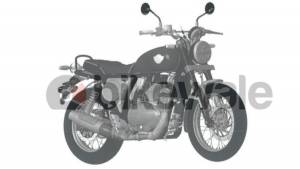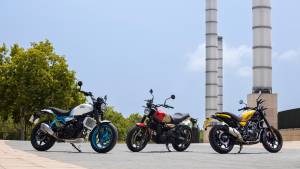Siddhartha Lal, CEO Royal Enfield talks about the new 650 Twin and the UK Technical Centre
OVERDRIVE: How did the 650cc twin-cylinder project begin?
Siddhartha Lal: My understanding is that the first sketches and designs were made in January 2014. Obviously that means we had started thinking about it before that. But in fact, it started life as a 600cc twin. smiles But we weren't confident of meeting the ton. That's 160kmph or 100mph. So we eventually upgraded it to 650 and now it certainly crosses the ton.
OD: Really? Did you consider a larger displacement as well?
SL: No. It just went up from 600 to 650. Its the only step we have taken.
OD: What's the top speed on the new bike, then?
SL: Laughs Oooh, its above a ton. I don't even have the top speed on me but I know that on the track they've done well over 100 miles an hour
OD: What did you feel when you ride the first near-final prototype
SL: Laughs I don't look like a very emotional fellow but when I do ride bikes like this for the first time, it does touch me quite a bit. I just said to myself that I don't want to think about this too much. It's really nice and it's still three years away. It sounds too far away because we have started doing these very early in the process. So the 90 per cent tooled-up motorcycle was available nearly two years before now.
That's so far. But now, you know, we have really taken a much more calculated, restricted and developmental approach to all of these things that are. Our development cycle is absolutely world class. Our validation cycle is absolutely world class. And a lot of standards have now been set up not just 10-20 per cent but some of them are three times more than what some of the other people are doing. We have really taken a different approach to developing this. And its taken time.
OD: You could literally create any motorcycle you want, versus us who can buy motorcycles we like. How does that feel?
SL: Thinks quietly for moment before answering. It's the same. It's exhilarating! But it's also a lot of pressure because you have to do it right. You have to do it right for the customers. You have to do it right for everybody, to make sure that no stone is unturned and its taken us a lot to get to that stage. I believe where we can say that we have really done what it takes and its painstaking. And then you get to the business side of that and that always pulls you down a bit you know.
The motorcycle side is gorgeous and fun and then you have to take decisions. Cost decisions, conflicting requirements from different places and all those things come in but its still always exhilarating.
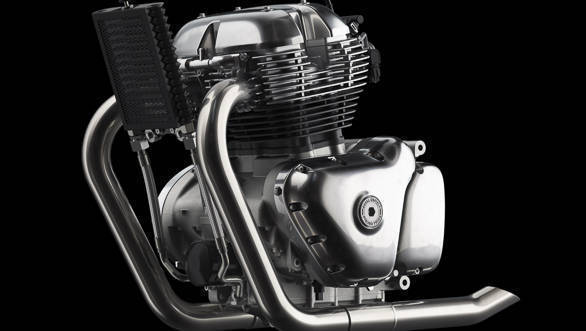 That's the engine head of the new Royal Enfield 648cc parallel twin. It gets a 8-valve SOHC configuration and the beefy new slip-assist clutch
That's the engine head of the new Royal Enfield 648cc parallel twin. It gets a 8-valve SOHC configuration and the beefy new slip-assist clutch
OD: Is there anything those hard decisions made you leave out of the new engine?
SL: No! We wanted it air-cooled, it's air-cooled. It was a tough sell because everyone figured that at this displacement, specially to meet Euro V and BS-VI, it must be water-cooled. But we believed it must not be water-cooled. And that we can achieve what we want to with an old-school air-cooled engine.
I wouldn't say there are any of those level of compromises. Perhaps it's not the lightest engine. But we wanted it to look pretty as well takes a long look at the engine and we have done that. So maybe on the weight, its perhaps a couple of kilos more than I would have personally liked but nothing to regret really.
OD: Your first global motorcycle, global R&D... what learnings have gone back home? And to your older products?
SL: I would say that a lot of it has gone back to the older product line because this is the same team doing this product and the older products. The most stable product - not just at Royal Enfield, but of any company - is the running product.
That, today is the 350 UCE. The type of fault frequency we get is absoutlely world class. The kind of failures we get are very minuscule and minor and the warranty issues we have... are nothing, no issues really.
So we have taken back a lot of things. What we've been able to achieve with this engine, really, was to go from our singles which was largely I would say low-end performance to what this engine is, which is low- and mid-end performance. It's [the 650 twin] not still very high-end. You don't go beyond 7,500 revs and all that but it does give you very good performance up to around 7,000rpm.
I think what we are going to take back is maybe - at the cost of a bit of character - is a bit more refinement on the engine. We still love our singles but we have learnt that a bit of balancing does help in long distance riding. For city riding, it's absolutely fine but if you're going for hours and hours, it could get tiring for some people.
There is a lot more. I mean we've gone to four valves, to overhead cams - we've done that before as well but - interesting learnings for sure.
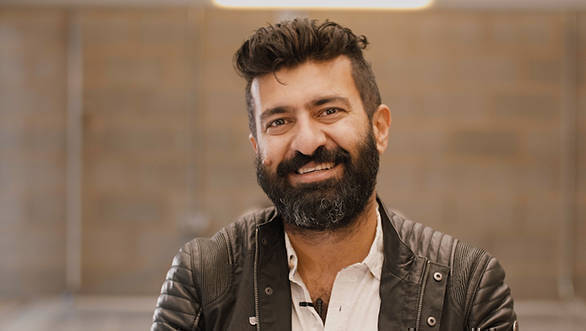 Siddartha Lal, CEO Royal Enfield and MD Eicher Motors laughs during our interview at the reveal of the new 650 Twin and the Royal Enfield UK Technical Centre in Bruntingthorpe, UK
Siddartha Lal, CEO Royal Enfield and MD Eicher Motors laughs during our interview at the reveal of the new 650 Twin and the Royal Enfield UK Technical Centre in Bruntingthorpe, UK
OD: India roll out plan?
SL: We expect India to be the largest potential market for these motorcycles, even though there isn't any market for motorcycle such as these in India right now. But we expect to start delivering motorcycles after April. But that's still expectation and lot of things still have to go right [first]. And its only after that we will really be able to start servicing the Indian market.
Because the requirements there are much more. Markets outside we can still deliver smaller numbers and that's okay but India you know we can't. We had the [Royal Enfield] dealers here [at the UK Tech Centre] a few days ago and they've said don't give only five dealers motorcycles. When you give these motorcycles, we want it nationwide otherwise people from our town are going to run to the big towns and buy motorcycles and it's going to create havoc everywhere.
When we are ready, and totally ready, with a ramped up capability, when we can service the market... We don't want to enter and then slow down and then starve the market. So when we are ready which will be after April, then we will service India.
OD: India on the first wave of markets, then?
SL: Likely not. Because you know we want to serve markets which have a greater summer season. Markets like here in Europe and all that. So we will likely come to markets where there is a much more seasonal effect and serve those markets [first]. And India in any case there's no way of serving India till we ramp up our production to very high levels.
OD: What's next after the 650 Twins?
SL: As you can see the cues from the engine, it's pretty damn classic and old school, and that is the direction and cues coming along for the next five years. We do have a firm five year road map. Firm means there are still some changes that happen every now and then you know some new norms come in. There's a tentative plan beyond that as well. And they're all - I can tell you right now - middleweights - between 250-750. They're all relatively, I wouldn't say necessarily old-school but they're certainly not super-modern vehicles. Modern is the wrong word again. They're not extreme vehicles, let''s put it that way. They're all in the realm of what we are doing and just extending what Royal Enfield is one step at a time.
So the same way at GT extended us one step out, the same way that Himalayan extended us one step out, the same way that 650 Twins will extend us another step out, so that's a single step outside of, let's say, our core of UCE 350s. And in that same way, you'll see one more step out, another step out now and then. Not some alien product sort of zooming in.
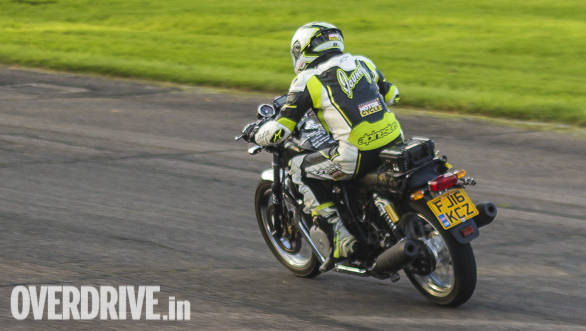 That is the new Royal Enfield 650cc parallel twin which was revealed to be producing 47PS and 53Nm at an event at the company's new Technical Center at Bruntingthorpe in the UK.
That is the new Royal Enfield 650cc parallel twin which was revealed to be producing 47PS and 53Nm at an event at the company's new Technical Center at Bruntingthorpe in the UK.
OD: How does UKTC and Chennai work together?
SL: The UKTC physical infrastructure has been around for less than a year, but the people have now been around for three years. So the head of product strategy globally for RE sits here, the head of engine design, the head of chassis design, the head of program management of product strategy and industrial design... This is their home. They have teams here and back in India. But their boss, the CEO sits in Chennai as well. So he helps coordinate the entire Chennai efforts.
So we basically see this facility as a... for twins - now we can say twins laughs finally. We see this more as a lead design and development center for twins and bigger motorcycles and the team here is taking the absolute lead in those and Chennai playing more of a support role.
But think of Chennai as the lead for singles for examples. And some of the expertise and support is coming from here for that.
There is a huge amount of interaction which happens. We allow people to really work in the way they want within our new product introduction process. But we insist that people travel a lot. So you'll see people from Chennai here all the time. You will see people from the UK Tech Centre in Chennai all the time, so there's a lot of collaboration.
All our gate meetings - there are a hell lot of gate meetings. We have in the normal process eight gate meetings, but launch gates are separate which are another 4-5 gates. So everybody converges and huddles for gate meetings. Very rarely we do it on big video conferences, most often it's physical so you get to meet, go have a beer and we get to have a chat, get to ride and a lot of them are around motorcycles examples - prototypes or mules or other things and we get to ride those. We get to go here [Bruntingthorpe], we go in Spain, we get to go to the test track in Chennai. And that's always bonding when you ride together.
OD: You've become the world's most profitable company and many competitors are now gunning for you
SL: Success has it upsides - we have a strong balance sheet, we do a lot of things we couldn't do earlier. It also has its pitfalls which is largely that you don't want to rock the boat too much. You don't want to lose what you have already got. And many years ago we had nothing to lose so we could play exactly as we wanted. Now we have something to protect but I believe that the way we are playing it that we have nothing to lose. That is how we are going for it.
We are not looking at building more and more protection around this. We are building new ideas, going to new places and we have our own products which cannibalise our own and people get terrified of that and we don't get terrified of that. Of course, there is some protection that's necessary but that isn't product related.
The way we are doing it is, I'd say, we are creating a wider network, of an ecosystem around our motorcycles. If you have a riding culture which our customers are getting accustomed to. If they build bonds together, their are tours, rentals, customisers who use our products to make other interesting stuff that creates and ecosystem. That's the way we are protecting all of this, not by holding tight and doing that.
OD: Direction for the company from here? Especially India
SL: The way we look at how the company has to evolve is that there are many areas where have to just to meet basic requirements that our consumer is looking for. And we believe we are either there or nearly there in most of those areas.
On top of that we have to create areas of absolute excellence so, some viewpoints: Our distribution network today, I believe in India, is perhaps the best premium motorcycle distribution network in the country. Other networks, there are some which are much bigger than ours but they are you could say not very premium in nature so we have created a network which looks premium and now is more and more behaving premium. It's the type of training, the type of work, the type of HR culture that we are building amongst our dealer employees, the type of parts availability, the type of service culture... we are putting a lot of energy behind our retail environment.
We have now 15 different regions in India and we are not very centrally controlled. We have a lot of freedom for our regional team members. This is not just a sales and service guy - there are rides community managers, there are people in marketing down there, there are activation people, there's HR, finance they can take decisions on warranty, service, on rides, on events, on local level activity... so they are building and forming communities.
Till now our view of India, or at least mine, is that we are very city centric. But where Royal Enfield has gone down to is D-towns and E-towns. And in those places when people are aspiring to buy a Royal Enfield we have a community there. We have people there who understand them very well and that's very different from just an old-school sales and service network.
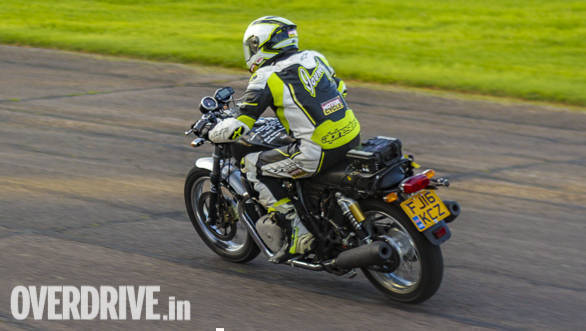 This is a prototype ridden by Royal Enfield's official test rider that did a fly-by as we were taken around the Bruntingthorpe Proving Ground, including the near 3km runway at the former USAF base. You can see the twin-shock rear suspension and the normal raised handlebars clearly apart form the test equipment mounted to the back of the bike
This is a prototype ridden by Royal Enfield's official test rider that did a fly-by as we were taken around the Bruntingthorpe Proving Ground, including the near 3km runway at the former USAF base. You can see the twin-shock rear suspension and the normal raised handlebars clearly apart form the test equipment mounted to the back of the bike
OD: Where would you go ride? Which of these bikes would you take?
SL: laughs Which of these bikes? That's a question for day after tomorrow [The Milan show unveil]. Where would I go. It would have to laughs I have been very, very curious about Latin America since I visited Colombia. And I fell in love with that country and that would be one of my primary motivations. It will be work trip laughs.
